Nov 15, 2021
When the Costs Hit Home, Nobody will Give Up Fossil Fuels; Be Thankful That COP26 Has Ended
Francis Menton
When The Costs Hit Home, Nobody will Give Up Fossil Fuels - November 19, 2021
As noted in my post this past Sunday, no amount of fake happy talk in the so-called “Glasgow Climate Pact” can obscure the obvious fact that nobody agreed to anything. To read the text of the “pact,” everybody claims to think that this whole “decarbonization” thing to “save the planet” is real. We’re all going to do something really, really significant, but it will be next year, or maybe the year after that. And meanwhile, nobody has made any remotely serious effort to cost this thing out. Are we talking about a ten percent increase in the cost of energy for this decarbonization project, or will it be a doubling, or maybe a tripling - or maybe even a multiplication by ten?
With tens of trillions of dollars at stake in the world economy, let alone the majority of humanity at risk of energy poverty, you would think that we would be far down the road toward detailed engineering studies of what the decarbonized energy world will look like and exactly how much it will cost. But it is exactly the opposite. Everywhere - or at least everywhere in the Western countries - government functionaries with degrees in English or Political Science (or maybe Gender Studies) issue edicts that carbon emissions will be reduced “50% by 2030” or “90% by 2050,” without any knowledge or understanding of how that may be accomplished.
So, as the costs of attempting to “transition” away from fossil fuels start to hit home, will anybody actually go through with the project? I think that the chance of that is about zero. China and India show how it works. To judge by their actions (rather than their words), they have long since figured out that solar and wind energy can’t succeed in running a modern economy, so they mouth empty platitudes to placate the Western zealots, make unenforceable promises that only come due after everyone is dead, and forge ahead with massive development of coal power. And even more telling are recent developments in Western jurisdictions. When the first hint arrives that fossil fuel restrictions are going to impose cost increases large enough for meaningful numbers of voters to notice, even the bluest of blue U.S. states take about three minutes to abandon their “decarbonization” promises.
.....
...perhaps most notable is what has happened in recent days in some of the bluest of blue U.S. jurisdictions. In 2010, some twelve Northeast states, plus the District of Columbia, entered into a kind of agreement to agree to form something called the “Transportation and Climate Initiative.” The language of the official document was all about “reducing greenhouse gas emissions”; but in practice this was from the get-go intended as a cap-and-trade scheme, which would use a restricted and decreasing supply of permits to gradually force up the price of transportation fuels (mostly gasoline), and thereby force the people to use less of them. The signatories to the initial document included all of the New England and Mid-Atlantic states.
The Boston Herald has a piece yesterday (November 18) summarizing the TCI program and its current status. First, as to the intent of the program and how it would work:
TCI would have capped carbon emissions by forcing fuel companies that exceeded limits to buy additional permits and invest those proceeds into green transportation and climate-resilient infrastructure. It aimed to reduce vehicle emissions by 26% by 2032.
Well, gasoline prices are now up about 50% since President Biden took office in January 2021. Perhaps you might think that the TCI states would be unable to contain their excitement, and would be plowing ahead to raise prices still further and force a rapid decline in consumption. But actually the opposite is occurring. First of all, only a handful out of the twelve original states plus DC moved forward to join the compact:
Initially, 12 states plus the District of Columbia were in talks to enter the agreement, but just Massachusetts, Connecticut, Rhode Island and D.C. eventually signed a memorandum of understanding by December 2020.
And now, with gas prices rapidly rising, what politician wants to be seen as forcing them up still higher? So even the few deep-blue states that had joined TCI are now heading for the exits. The Herald reports that Connecticut pulled out of the compact on Tuesday (November 16); and yesterday (November 18) Massachusetts followed:
Gov. Charlie Baker has pulled the plug on a regional climate initiative that would have capped tailpipe emissions and was projected to hike gas prices at a time of record inflation, admitting the multi state-deal is “no longer the best solution.” He backs out of the Transportation and Climate Initiative just days after Connecticut did.
A Massachusetts group called Mass Fiscal Alliance calls it correctly:
“TCI is a regressive gas tax scheme that would have hurt (the) middle class and the working poor the most. It’s such wonderful news to see that Massachusetts families will not be forced to endure the economic hardship TCI would have imposed upon them,” said [Mass Fiscal Alliance] spokesperson, Paul Diego Craney.
Meanwhile, New York moves ahead with its ignorant bureaucrats issuing edicts for the end to fossil fuels a few years out. At this point the voters remain almost entirely unaware of what is coming. But when the costs start to hit home, will we actually stay the course? No, we won’t. It will be fun watching the process unfold.
--------
November 14, 2021
If you have been following the news at all for the past several weeks, you know that the latest gigantic UN “climate” conference, going by the name COP (Conference of Parties) 26, has been taking place in Glasgow, Scotland. Mercifully, it ended yesterday, Saturday, November 13. All of those hundreds of private jets have now flown home.
Every time one of these UN confabs takes place, you have to hold your breath fearing that some tremendously damaging result will emerge. But, reviewing the final outcome of this latest conference, my comment is that we climate realists have gotten about the best result we could have hoped for. If you read some mainstream news sources, you may well get exactly the opposite impression. So let me give my reasoning.
At this point, there are basically two paths that the world might take in the movement toward so-called “decarbonization” of the energy system:
Path 1 is the path of strict world socialism. Of course, this is the preferred path of climate activists and UN bureaucrats. In this scenario, the entire world is forced, through binding international agreements, into an energy straight jacket, mandating reduction and then elimination of the use of fossil fuels within two or three decades at most.
Path 2 is what happens when there are no compacts with material binding worldwide energy restrictions. On this path, everybody talks a good game about decarbonization but, lacking meaningful binding agreements, most of the countries, with most of the population, continue to pursue whatever energy system is most reliable and cost effective. In practice that almost inevitably means fossil fuels for most to all applications. Meanwhile, a small number of wealthy, small-population jurisdictions that somehow become obsessed with the perceived virtue of eliminating fossil fuels - likely examples being Germany, California, New York, the UK, and perhaps South Australia (aggregating about 2-3% of world population) - will push the limits of decarbonization and intermittent renewable energy sources. They will then be the guinea pigs for the rest of the world to find out whether a decarbonized energy system can be made to work, and at what cost.
The end of the COP26 conference has shown that we are not on Path 1, and are unlikely to go there.
The key difference between the two scenarios is what happens in the nearly inevitable circumstance where the new “decarbonized” energy system fails to work cost-effectively or reliably, leading to enormously increased prices, shortages, and/or frequent blackouts. On Path 1, when that happens, the world’s people get forced into universal energy poverty with no obvious way to escape, and the bureaucrats and left wing press undoubtedly find some way to blame oil companies or some other capitalist bogeymen for the disaster. On Path 2, the 97-98% of the world that has not committed energy suicide can sit back and observe while the guinea pigs self-destruct. Eventually, the people in the guinea pig jurisdictions will catch on that they are being forced to pay a multiple of a reasonable price, and for energy that does not work very well, and they will replace their politicians.
How long will it take for these suckers to catch on? It could take a long time. Note that California and Germany, with self-inflicted energy prices well above those of surrounding jurisdictions, continue to double down and vote for more of same. But then, they are very wealthy jurisdictions, and it is their own problem.
And by the way, if the guinea pigs succeed in decarbonizing at little to no cost in either money or reliability, I will be the first to congratulate them. But they won’t succeed.
So let’s take a look at the outcome of COP26, and consider where this is going. See MORE here.
Nov 13, 2021
False Imagery and Foggy Data Hallmarks of COP26
By Vijay Jayaraj
Mainstream media is infamous for its exaggeration of everyday events. When it comes to the issue of climate change, it rarely misses an opportunity to promote fear. True to form, during the ongoing COP26 climate conference in Glasgow, media promoted incorrect information spewed by politicians and famous personalities.
Special attention was drawn to the assertion that rising sea levels are threatening island nations by none other than Barack Obama, who incongruously has purchased a multi-million-dollar ocean front property on the New England coast.
Catching the attention of millions was the image of a Tuvalu minister standing in knee-high sea water. But there is a problem with this: Most islands in the South Pacific nation of Tuvalu have gained surface area and are in no danger of being inundated.

Despite sea-level rise that has been underway since the end of the last ice age, Tuvalu’s land area has increased recently by 2.9 percent. A peer-reviewed research paper which studied four decades of shoreline change in all 101 islands in the Tuvalu atolls categorically proves this.
The paper notes that “...change is analyzed over the past four decades, a period when local sea level has risen at twice the global average (~3.90/+/- 0.4mm.yr-1). Results highlight a net increase in land area in Tuvalu of 73.5 hectares (2.9%) despite sea-level rise and land area increase in eight of nine atolls.”
The case of Tuvalu is not unique. Various island nations have gained landmass in recent decades, including Maldives which increased by 37 square kilometers since 2000.
The climate doomsday machine has been using this image-based propaganda for a while now. National Geographic circulated an image of a starving polar bear and claimed that the bear’s condition was a direct result of man-made climate change.
However, polar bear populations are relatively healthy and have increased in recent decades. When exposed, the famous media channel issued a statement saying that the reason for the dismal condition of the bear is unknown and that it had exaggerated the climate impact.

At COP26, Bill Gates joined climate elites who resorted to a representation of reality designed to promote climate fear. “Farmers in low-income countries are at high risk from the impacts of climate change,” said Gates. But a closer look at weather data and the state of global agriculture reveals a different picture.
The United Nations makes clear that there is no strong evidence that climate change is having a significant influence on the frequency of extreme weather events. IPCC AR5 WGI Chapter 2 states, “In summary, there continues to be a lack of evidence and thus low confidence regarding the sign of trend in the magnitude and/or frequency of floods on a global scale.”
When it comes to droughts, the report states that “...there is not enough evidence at present to suggest more than low confidence in a global-scale observed trend in drought or dryness (lack of rainfall) since the middle of the 20th century.”
Consider India, a country with the world’s largest number of low-income farmers. More than 500 million people depend either on agriculture or allied products. Of that total, 150 million depend only on agriculture - the equivalent of 40 percent of the U.S. population.
These farmers - with an average monthly income of less of $120 - depend on monsoon rainfall and there has been no climate signature on the monsoon rainfall trend. Nor has there been any increase in cyclones.
In other words, there has not been any increased risk from climate change for India’s farmers. Another indicator of the absence of heightened risk is crop production. For four consecutive years, India has produced record food crops, higher than ever before in its history.
You would think that Gates would know something about agriculture and climate given that he owns 242,000 acres of U.S. farmland and is said to be the largest private owner of such acreage. However, it appears that the billionaire is at best ill-informed.
Though fancying themselves to be noble defenders of nature, these purveyors of doomsday scenarios are more akin to a cult’s priesthood offering commoners salvation in exchange for prosperity and freedom.
Vijay Jayaraj is a Research Associate at the CO2 Coalition, Arlington, Va., and holds a Master’s degree in environmental sciences from the University of East Anglia, England. He resides in Bengaluru, India.
Nov 11, 2021
Antarctica’s Coldest Half-Year Since Measurements Began 60 Years Ago
Temperature Bottom Falling Out: Antarctica’s Coldest Half-Year Since Measurements Began 60 Years Ago
By P Gosselin on 9. November 2021
Antarctica sets a record cold six month period...Neumayer station sets new winter record low, sees rapid cooling since 2000!
German Die kalte Sonne here features Antarctica’s record cold winter - the coldest since temperature measurements began some 60 years ago.
Coldest April-September period
The Amundsen Scott station at the South Pole recorded a mean temperature of -60.9C for the April 1 to September 30 period, according to the US National Snow and Ice Data Center (NSIDC). For the June-July-August period, the mean was minus 62.9C the second coldest recorded.
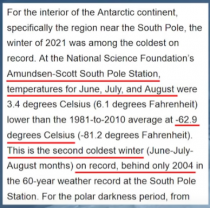
Enlarged
Image: Die kalte Sonne.
Apparently the 140 or so ppm added CO2 couldn’t trap enough heat to prevent a record cold from being set. The previous record for June-July-August was set in 2004.
Neumayer sets record cold, sees 3C of cooling since 1985.
Die kalte Sonne reports that a record was also set at the German Neumayer Antarctic station, located on the Antarctic coast, which saw a mean June-July-August temperature of -28.6C.
Recording at the Neumayer station began in 1985, and the linear trend over the past 35 years has fallen by almost 3C! It’s been cooling even faster since 2000:
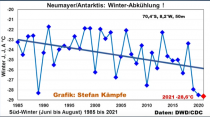
Enlarged
Rapidly cooling Antarctic. Chart: Stephan Kampfe. Data: DWD.
The German Neumayer Antarctic station has seen a distinct cooling trend since 1985, according to data from the German DWD national weather service. This is not getting reported by the media in Germany in any way, shape or form. We can just imagine the blaring headlines if the trend instead had shown 3C of warming. You’d have a thousand German journalists descending on the South Pole by now.
Record warm reading gets discarded
Last February, for example, the German Berliner Morgenpost reported how for the first time the temperature had climbed over 20C at the northern tip of the Antarctic peninsula - Seymour Island. “At the South Pole, climate change is very clear,” declared the Morgenpost.
However a subsequent World Meteorological Organization (WMO) investigation found the reading had in fact nothing to do with climate change, Die kalte Sonne reports:

Enlarged
Image: Die kalte Sonne.
The 20.75C “record” reading resulted from a faulty instrument, and thus was nullified last July.
Yet, activist groups like Germany’s DUH don’t want to hear any of it. They continue to cite the nullified record even today for gathering petition signatures.
Oct 31, 2021
Developments in climate change science
Alan Moran, Director of AEF -
Delving into the latest IPCC report, Judith Curry finds this projection to 2035, at which time the “running hot” models are projecting temperature levels between almost the same as today and a little over 0.5C warmer.

Enlarged
Richard Lindzen notes that global temperatures have increased 0.5C since 1960, noting “Despite the fact that increases of CO₂ thus far have been accompanied by the greatest increase in human welfare in history, and despite the fact that there have been large increases in the Earth’s vegetated area largely due to increases in CO₂’s role in photosynthesis, governments seem to have concluded that another 0.5 C will spell doom”.
Blogger Geoff Derrick distills the following chart of recent global temperatures from the UK Met Office Hadley Centre showing no warming since 2014.

Enlarged
-----------
Icecap Editor Note:
The best data shows no warming this century.
See the Climate Reference Network plot of Monthly Average US temperatures since inception in 2005 and the constructed data from the US climate divisions back to 1998’s super El Nino.

Enlarged

Enlarged
And the average monthly maximum temperatures for the US climate divisions.

Enlarged
See much more detail on the true temperature story here.
Please share freely. Help us get the word out with a secure Paypal donation (left column home page).
------------
Roger Pielke condemns UN Secretary-General Guterres for wrongly and irresponsibly calling the latest IPCC report a “code red for humanity”. The report claims that heatwaves and extreme precipitation will be more frequent but not floods, hail, lightning, hurricanes, strong winds and droughts.
The Observer Research Foundation (an organization partnered by Apple, Bill Gates, Uber, Google, and Microsoft) says climate change threatens India’s food security. That assumes Indian agriculture is highly vulnerable to climate disasters. But India’s agricultural output is at record levels, and projected to grow due to increased rains from warming oceans.
Having called out “scientists” inventing a global warming-induced collapse of the Great Barrier Reef, Dr Peter Ridd was subsequently sacked from his James Cook University position for disloyalty. The High Court found provisions in university codes of conduct that seek to prohibit robust, aggressive and acrimonious debate are inconsistent with intellectual freedom. Ludicrously, the Court also concluded that Dr Ridd should have followed University’s confidentiality directions but to have done so would have made it impossible for him to contest the case. Parliament is to pass laws clarifying intellectual freedom.
Developments in climate change economics
In response to massive energy price hikes in Europe, Frans Timmermans, the EU’s climate chief, adopting the ostrich approach, says the solution is more renewables, not fewer. US Treasury Secretary Janet Yellen says the answer is storage but omitted to say what the cost would be. Eric Worrall has put a $50 trillion price tag on batteries that would allow just 5 days storage in a wind drought.
UK Energy Secretary, Mr Kwarteng claimed that despite the shift from coal to renewable energy in the last ten years “the costs haven’t gone up”. But the Office for Budget Responsibility (OBR) says subsidies to renewables now add 10 billion pounds a year to electricity consumer costs, even excluding all the increased system management and grid expansion costs. While Boris Johnson claims the UK will achieve net zero without “a hairshirt in sight” Treasury points to a cost of 60 billion pounds a year by the next decade and, as the Spectator notes, “Government estimates are notoriously inaccurate”. The Daily Mail described Johnson’s eco dream as “the longest suicide note in history”.
UK government has a gas crisis. In pursuing a greenhouse agenda, it has prevented new North Sea developments and has banned fracking of gas in the abundant onshore resources.
Norway’s new left-wing government is, however, not sacrificing its own coal and oil to global concerns as it steps up new drilling.
Ominous for the world, disastrous for Germany: Social Democrats, the Green Party and the Free Democrats join for a “fresh start” and pave the way for an ecologic modernization of the economy that complies with climate targets. Yet, one month after the September election the green coalition is not yet operational with the three parties focussed on higher energy prices.
Bucking the trend, French Presidential hopeful Marine Le Pen, the head of the National Rally (RN) party, has said she would take down France’s wind turbines and end subsidies for renewable energy if she was victorious in next year’s elections.
Edwards, Dobson and Owen estimate that to firm-up intermittent energy in the UK with 50 per cent wind supply and 10 windless days would require 5 TWh of battery storage at a cost 1.5 trillion pounds.
Oct 18, 2021
Introducing David R. Legates, recipient of the 2021 Fredrick Seitz Memorial Award
By Ken Haapala, President, Science and Environmental Policy Project (SEPP)
Introducing David R. Legates, recipient of the 2021 Fredrick Seitz Memorial Award.
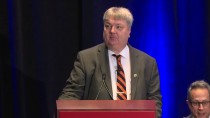
Physical Science develops with the constant conflict between ideas and evidence. What ideas best fit the physical evidence? When the physical evidence changes the ideas must change accordingly. Otherwise, the science becomes stagnant, dogmatic. That is what is happening to the science claimed by the UN Intergovernmental Panel on Climate Change (IPCC) and its followers, including many once noted US science institutions.
In 1988, the UN established the IPCC to (1) assess the scientific information related to changes in climate from emissions of greenhouse gases and 2) formulate realistic responses. The IPCC issued its first report in 1990.
Since then, a great deal has changed including:
1) human conditions have greatly improved thanks to the use of fossil fuels.
2) the physical evidence of what is happening in the atmosphere with increasing CO2 has greatly improved
3) the attitudes of Western governments to changing science have worsened
Over the last 30 years, one of the most remarkable changes is the tremendous reduction in people living in extreme poverty. Extreme poverty is defined as person having a local purchasing power of $1.90 a day. It is estimated in local currency and adjusted to inflation and similar issues. The estimates used here come from Our World In Data and were updated in 2019
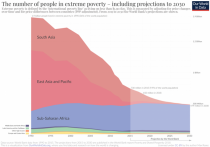
Enlarged
As you see, 30 years ago 1.9 billion people 36% of the world’s population lived in extreme poverty, mostly in Asia. Extreme poverty is life on the edge of death. In 2018, 650 million lived on the edge, about 9% of the world’s population. The great reduction in those living in extreme poverty is despite an increase in population of about 43%.
From 1990 through 2018 the world’s CO2 emissions increased by 60%. China’s CO2 emissions grew by 315%, more than three times. Today, Asia emits more CO2 than all other continents combined.
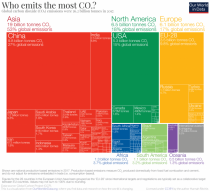
Enlarged
A second remarkable change is Space Age Technology which gives us the ability to observe and measure what is occurring in the atmosphere, where the greenhouse effect occurs. This evidence contradicts that early scientific speculation. Despite a 60% increase the influence of CO2 on global temperatures is modest, and not dangerous.
A third remarkable change is the obstinance of Western Governments and many western science institutions in ignoring the changing evidence. Contrary to the scientific method they are refusing to adjust their views, which they still call scientific, to the great expansion in physical evidence about the atmosphere and the effects of carbon dioxide. With mounting physical evidence, what began as a scientific speculation has drifted into world of science fiction and political myth.
Washington DC is a hotbed for science myths and attacking all who dare question them. Our honoree had already experienced what happens to physicists who challenge the accepted myths with physical evidence. In his experience in estimating precipitation, he always advocated those measurements must be checked and double checked, and when scientific concepts do not meet the evidence from experiments and observations, the concepts must be change. This winter, when given an opportunity he bravely stood up, and with the support of a few, declared certain myths popular in Washington are not science, and explained why.
Ladies and gentlemen, I have the privilege to present to you the honoree of the 2021 Fredrick Seitz Memorial Award, Dr. David Russell Legates
|















